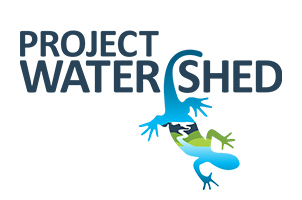Project Watershed is Battling Reed Canary Grass
Few species will eat it and it grows too thickly for animals or waterfowl to use it for cover or nesting. Foraging juvenile salmon have feeding opportunities reduced in areas dominated by this grass. It also out-competes trees and shrubs which provide important stream-side cover and keep water temperatures cooler. In particular, dense stands are starting to form in the Hollyhock Marsh conservation area, Dyke Slough and the lower reaches of Mallard Creek. In fact it is starting to constrict the creek impeding fish access.
As part of our work to control and manage this invasive grass we have been doing some test treatments. Specifically mowing, mowing/shading (with cardboard) and digging it out. We are currently monitoring how effective these treatments are, and we will soon be developing a control plan for long-term management of this invasive plant. You may notice our crew out in the estuary this summer doing some of this work. If you come across areas where we are working on controlling the grass with cardboard we ask that you not disturb these sites.
We would like to acknowledge the financial support we have received for this project from the Fish and Wildlife Compensation Program and the cardboard that has been kindly held and donated by Mountain City Cycle.
We are looking for volunteers to help with this work. Specifically, we need volunteer help to:
1. Prepare cardboard – we have been using large bicycle boxes. All metal staples, tape, and plastic labels need to be removed from the boxes before we can use them for shading.
2. Prepare coat-hanger “stakes” for staking down cardboard shading. This involves using wire cutters to cut metal coat hangers, bending the hangers into stakes, and tying a piece of biodegradable flagging tape to each stake.
3. Lay out and stake cardboard over patches of mowed reed canary grass in the estuary. This work involves walking on uneven and slippery terrain.
4. Dig out small patches of reed canary grass.
Questions?
Please contact Bea Proudfoot at: maps.projectwatershed@gmail.com or 250-703-2871.
Related Posts
Fall and Winter Forage Fish Sampling
We’re gearing up for the fall/winter season of forage fish sampling!
Mallard Creek Riparian Planting
We will be planting native riparian species along a section of Mallard Creek that we recently cleared of invasive Reed canarygrass.
Fall Planting at Kus-kus-sum
We are looking for volunteers to assist us with planting native trees, shrubs, and marsh plants at Kus-kus-sum this fall!
A New Day for Forage Fish
Project Watershed and the Coastal Forage Fish Network (CFFN) are celebrating Surf Smet Day on October 25th! This adds another day on which to celebrate and raise awareness about beach spawning forage fish as Pacific sand lance are celebrated on a day in December.
Fall Work at Kus-kus-sum
We are looking for volunteers to assist us with weeding out invasive plants to make room for the native plants arriving later this fall!
Forage Fish Survey Techniques Workshop
The Coastal Forage Fish Network (CFFN) is hosting two one-day workshops to introduce development considerations and methods to survey for beach spawning forage fish for projects that may impact beach spawning forage fish.


